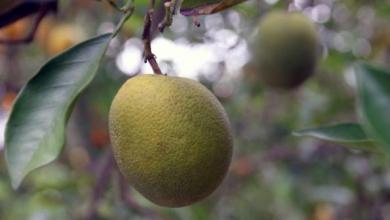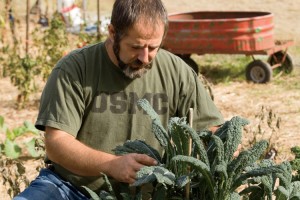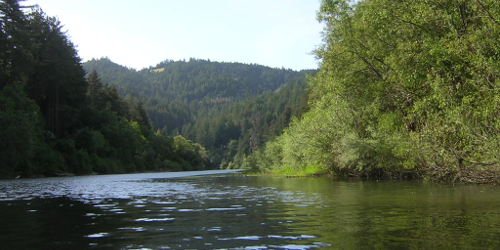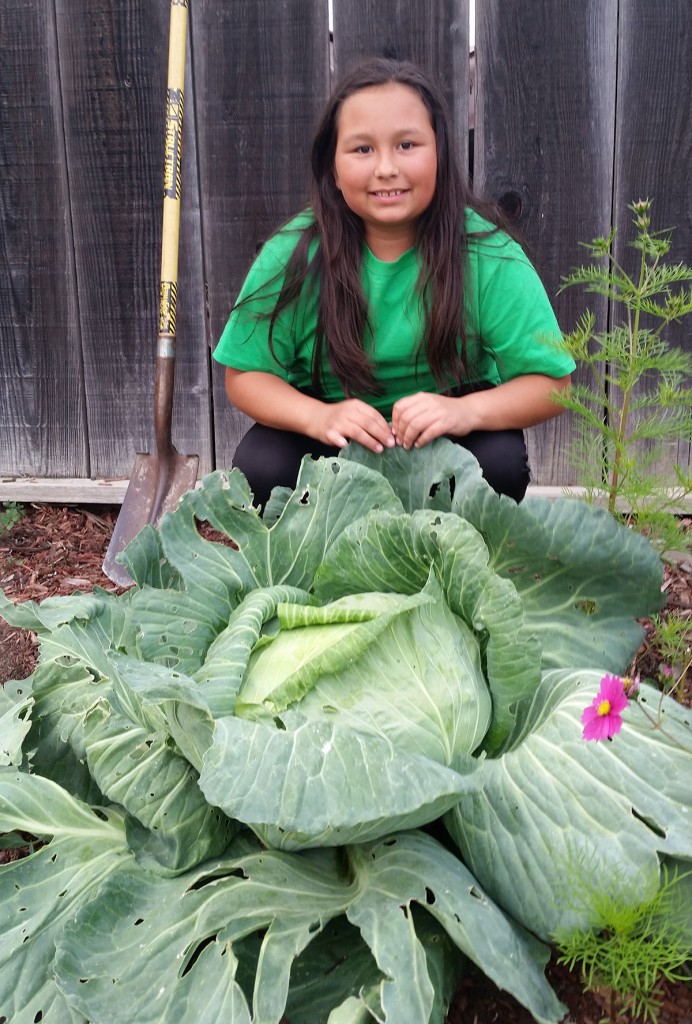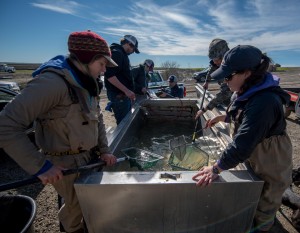
Researchers from UC Davis, CalTrout and Cal Marsh and Farms count, weigh and measure juvenile Chinook salmon that are going into experimental rice fields at Knaggs Ranch on the Yolo Bypass in February 2016. Credit: Carson Jeffres/UC Davis
An annual experiment to “plant” salmon in Yolo County rice fields aims to better explain how floodplains support strong salmon populations. Dubbed the “Nigiri Project” for its sushi-like marriage of fish and rice, the research is a collaborative project among the UC Davis Center for Watershed Sciences, the California Department of Water Resources and nonprofit organization California Trout.
For the first time this year, the agricultural floodplain habitat experiment will compare food web productivity and fish growth in three different kinds of river habitat.
For the course of the experiment, a group of juvenile Chinook salmon will be held in underwater pens on flooded rice fields, as in years past; a second group will be held in pens floating in an agricultural canal; and a third group will be held in floating pens nearby in the Sacramento River. The experiment began on Feb. 19, and the fish will be released after approximately four weeks.
“At this point, we feel confident that giving native fish access to the food-rich environment of the floodplain will play a critical role in recovering imperiled salmon,” said Carson Jeffres, field and lab director of the UC Davis Center for Watershed Sciences. “Now we are interested in how food made on the floodplain can benefit the entire river and Delta.”
Floodplains a ‘bug buffet’ for salmon
Born in the gravel of mountain streams, Central Valley salmon migrate to the ocean where they grow for one to three years before returning to rivers to spawn. Juvenile fish that are larger and healthier when they enter the ocean have better odds of returning as adults.
“Floodplain habitats are essentially a bug buffet for small fish,” said Jacob Katz, Central California director for California Trout. “Our previous results have shown that the food-rich floodplains appear to act as an important pit stop for juvenile fish, where they can fuel up on their downstream journey to sea.”
Unfortunately for hungry salmon, more than 95 percent of natural floodplain wetlands have been eliminated by the development of the Central Valley for farms and houses. In previous years, the Nigiri Project has shown that off-season agricultural fields can provide critical floodplain habitat for endangered fish.
“Fish have little opportunity to reap the benefits of floodplains because they are nearly all cut off from river channels,” said Louise Conrad of the California Department of Water Resources. “The Yolo Bypass is one of the last remaining active floodplain areas in the Central Valley. Enhancing the opportunity for salmon to access and use its floodplain areas could make a huge difference for salmon while also helping to recharge groundwater and improve flood safety.”
Four years of fast-growing fish
For four consecutive winters, experiments conducted on rice fields at the Knaggs Ranch property on the Yolo Bypass documented the fastest growth of juvenile Chinook salmon ever recorded in the Central Valley. These results suggest that through better planning and engineering, farm fields that produce agricultural crops in summer could also produce food and habitat for fish and wildlife during winter when crops are not grown.
The experiment suggests that floodplains on farmland can also be thought of as “surrogate wetlands” that can be managed to mimic the Sacramento River system’s natural annual flooding cycle, which native fish species evolved to depend upon. Agricultural runoff water is used to flood the fields for the duration of the experiment. This recycled water fuels the floodplain food web before being flushed back into the Delta ecosystem through agricultural canals, adding to the food supply for all fish living in the system. No new water is used to conduct the experiment.
This natural process of slowing down and spreading out shallow water across the floodplain creates the conditions that lead to an abundant food web. Sunlight falling on water makes algae, algae feeds bugs, and bugs feed native fish and birds. In contrast, very little food to support aquatic life is produced when rivers are narrowly confined between levees.
“California’s water supply for both people and fish will be more secure when our water policy works with natural processes, instead of against them,” Katz said. “This work leverages ecology as technology and points us toward efficient and cost effective real-world water solutions that support both fish and farms.”
The project was funded this year by the U.S. Bureau of Reclamation, California Trout, and California Department of Water Resources.
Link to blog post










